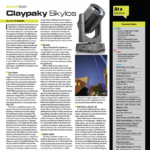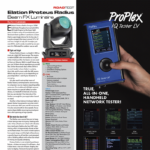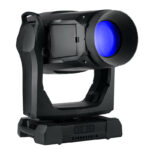Today, I’m playing with a brand new video strip just released by Upstaging Inc., based in Sycamore, IL out of the Chicago area. This stealthy, thin slice of LED packs a punch and is perfect for almost any application. They can easily be mounted to anything on display, from temporary stage sets and truss to permanent installations including museums and storefronts.
The Fixtures
The Saber LED is a 10mm pixel pitch video strip with two rows of SMD three-in-one LEDs attached to a black aluminum frame. The best way to picture it is if you had two rolls of LED tape laid side by side and fastened to a hard structure. To this Upstaging attaches perfectly thought-out cables to each end. I say this because each Saber can line up with the one next to it — horizontally or vertically — for a totally seamless line of pixels ready to map. In either direction, all the pixels remain evenly spaced with a perfect 10mm pixel pitch in any direction.
The Saber comes only in this high-definition 10mm pixel pitch model, but is available in 1 meter (1,000mm), .5 meter (500mm) and .25 meter (250mm) lengths. The total fixture is thin (less than an inch wide) and sticks out just under three inches without clamps. There is a unistrut-type bracket on the bottom allowing the user to easily mount the fixture to any set piece or attach a half clamp of any kind for hanging off of battens, pipes or trusses. There is a connector at either end of the strip for daisy-chaining multiple fixtures. The connectors are cut to precise lengths, allowing each fixture to butt up with the one next to it and connect without any bend in the cable or connector. After dealing with LED tubes and the constant soldering of worn connectors, this feature is a tech and owners’ dream.
The one-meter sections each weigh 2.65 pounds, so using one tight fit clamp per fixture is certainly viable. Because they are so easy to mount, users can also custom-build most lengths by attaching the strips to a longer piece of material. The sides of each Saber also have a metal groove modeled into them, allowing the user to slide a diffuser over the entire length. These optional diffusers are a white, frosted cover that slides over the fixtures front face and spreads the beam of each individual LED for a smooth effect. The diffusers themselves come in cylindrical shape as well as square models. The addition of these diffusers makes the Saber LED perfect for designers who want a product similar to the discontinued Versa-Tube, but on steroids. I say that because, along with trillions of color possibilities, this bad boy emits some serious lumens — 4800 NITS. I doubt any user would dare run these fixtures at full output. At full-on white, the one-meter models draw a maximum of 50 watts. The control box has them running at 48 volts DC, with the maximum power draw per meter at .5 amps. In real-life applications, the average power draw would be half of that. This fixture also has an IP rating of 65. This means the fixture can be used outside and will withstand some rain, but is not recommended for permanent installs where wet weather is common.
The Hardware Needed
Setting up a Saber system proved to be extremely simple. First of all, the premium way to run these fixtures is by attaching a media server or any video playback device running video signal straight into the processor itself via DVI or HD/SDI. Brompton Technology, based in London, manufactures the Tessera M2 processor. These computers have been around for years, running data into all sorts of video tiles. I’ve used them before and found them to be both easy to program and reliable. In addition to the processor, one needs the Saber Power Supply. This control box is basically a power and network data distribution system. Both the processor and control box have auto-sensing power supplies from 100 to 240 volts. Cables come straight out of the Control Box to the fixtures themselves. The custom cables (only available from the distributor at this time) contain both the power and signal necessary for the Saber to operate. A DisplayPort plug on the back of the Tessera feeds the monitor for getting the system set up.
To wire the initial system together, one just needs to add meters, as the whole thing runs off of dedicated amperage per home run cable. The video image is run into the processor via DVI or HD/SDI. The processor itself has four outputs that run to a control box. The cable length from the processor to the control box can be up to 100 meters in length. Any longer, and the user would need to add a network switch in-line. The control box has four outputs as well, with each cable going directly to the first Saber in line. The cable feeding the fixtures cannot be longer than 30 meters from the control box, and all cables that daisy-chain fixtures together must be less than five meters apart. Each control box themselves can power up a total of 20 meters of Saber LED strips. The maximum total length of fixtures that can be daisy-chain together is eight meters. So once the designer has figured out the placement of the fixtures on stage, connecting them all is simple math.
The Tessera processor is where one configures the system for use. When I turn it on, I am presented with a blank canvas on screen that is defaulted to a size of 1920 x 1080 pixels (WxH). From the library, I choose the type of fixtures I want for the show. Then it’s as simple as drag and drop as I move the various length Sabers into position on the canvas and rotate them to suit my needs. Then you tell the program how many of each type pieces connect to each port of the control box. This info gets stored on a memory card in the Saber Power Supply that remembers the info when turned off.
More Perks
This new product is ready for release, but software-wise, they are still adding features. For instance, if one wished to run the Sabers through straight DMX, it is possible. The processor has the ability to patch each Saber as an individual light fixture. Running on just four DMX channels for dimming and RGB values, one can run them this way, which may be perfect for a storefront or similar install, but then you cannot control each individual pixel per fixture with different colors. Currently the processor can receive a single universe of DMX via 5-pin XLR or Art-Net directly in. Another highlight of the processor is you can easily decide which Sabers you want to turn on in a scene and which ones you want to remain black. For instance, say you wanted to run video through just the fixtures that are hung vertically and ignore the ones hung horizontally. The processor can receive a command telling the Sabers to do just that. The manufacturers are presently working on a way for the control box itself to detect the Sabers plugged into it and patch them on their own.
At a Glance
With its wide array of color, intense brightness and ease of assembly and use, this fixture fills a specific niche in the live event market. From stunning outlines of stage elements to matrixes of dazzling running streams of color across the stage, the Saber is bound to become a staple of the touring and corporate markets.
PROS
Bright double LED strips, maintains 10mm pitch whether stacked or extended, GUI mapping technology. Structurally solid with great connectors. Rated for outdoor use.
CONS
None
STATS
Price Contact Upstaging directly at ?saberLED@?upstaging.com
Manufacturer Upstaging Inc.
More Info upstaging.com/saber



